Fermented foods are becoming more popular, and it’s easy to see why. They taste unique and are good for our health. This guide is for beginners who want to try making fermented foods at home. We’ll cover the basics, from the science to making sauerkraut and kimchi.
Key Takeaways : Fermented Foods
- Fermented foods are a healthy way to preserve produce and develop new flavors.
- The process of fermentation involves beneficial bacteria that convert sugars into lactic acid, which acts as a natural preservative.
- Fermented foods are rich in probiotics, which can support gut health and overall well-being.
- With the right tools and ingredients, you can easily make delicious fermented foods at home, such as sauerkraut and kimchi.
- Fermenting at home allows you to control the ingredients and flavors, creating customized probiotic-rich foods.
What are Fermented Foods?
Fermented foods have been a key part of many cultures for a long time. They bring unique flavors and health perks. The making of these foods changes sugars and carbs into lactic acid or alcohol with the help of bacteria and yeast.
This change happens without air, thanks to lactobacillus bacteria. They love the salty, acidic setting.
The Science Behind Fermentation
Lactobacillus bacteria eat the sugars and turn them into lactic acid during fermentation. This acid helps keep bad bacteria away and gives the food a tangy taste. The lactic acid fermentation also makes nutrients easier for our bodies to use and creates probiotic bacteria that are good for our gut.
On the other hand, anaerobic fermentation turns sugars into alcohol with yeast. This method is used to make drinks like wine and beer.
| Type of Fermentation | Outcome | Examples |
|---|---|---|
| Lactic Acid Fermentation | Lactic acid production, probiotic bacteria | Sauerkraut, kimchi, yogurt, kefir |
| Anaerobic Fermentation | Alcohol production | Wine, beer, kombucha |
The lactobacillus bacteria that start fermentation are probiotic bacteria. They help keep our gut healthy. So, fermented foods are great for a healthy diet.
Benefits of Fermented Foods
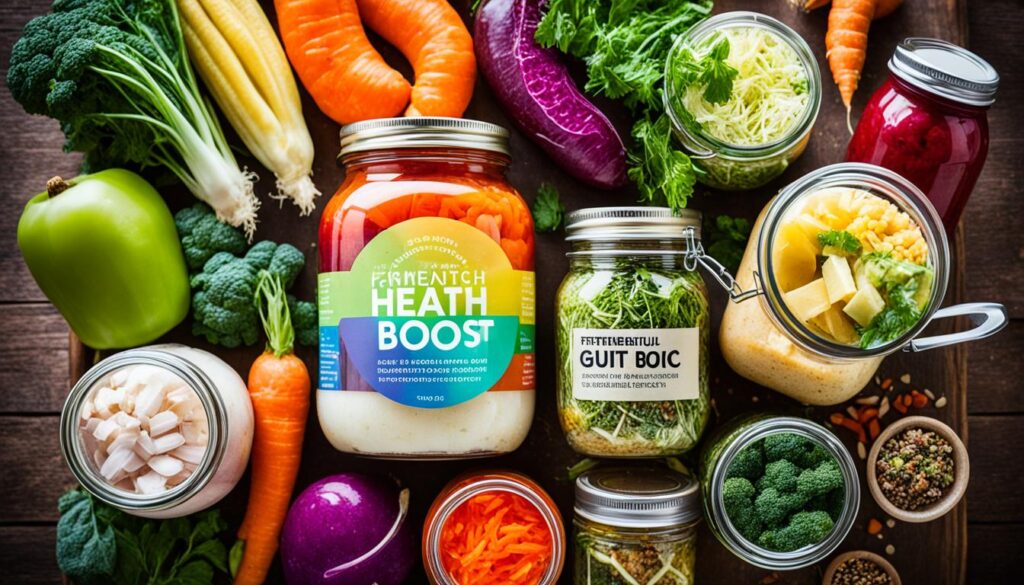
Fermented foods are packed with health benefits. They produce probiotics during fermentation, which help your gut, improve digestion, and boost your immune system. These foods also make nutrients easier for your body to use.
Not only good for your body, fermented foods can also help your mind. They support a healthy gut-brain connection, which can improve your mood and mental health. Adding fermented foods to your diet can make you feel better overall.
Gut Health and Digestion
The probiotics in fermented foods keep your gut bacteria balanced. This helps with digestion and getting nutrients from food. Research shows these foods can ease symptoms of irritable bowel syndrome and other gut issues.
Immune System Support
Fermented foods have diverse microbial communities. These can boost your immune system by making more antibodies and natural killer cells. This helps your body fight off infections and lowers the chance of getting sick.
Mental Health Benefits
The gut-brain axis shows a link between a healthy gut and better mood, thinking, and mental health. Fermented foods can support this connection, helping your mental well-being.
| Health Benefit | Mechanism |
|---|---|
| Gut Health | Probiotics in fermented foods help maintain a healthy balance of gut bacteria, aiding digestion and nutrient absorption. |
| Immune System | The diverse microbial communities in fermented foods can enhance the production of antibodies and natural killer cells, strengthening the immune system. |
| Mental Health | The gut-brain axis suggests that a healthy gut microbiome can positively influence mood, cognitive function, and mental health conditions. |
“Fermented foods are a simple, natural way to support your overall health and well-being.”
Tools and Ingredients for Fermenting
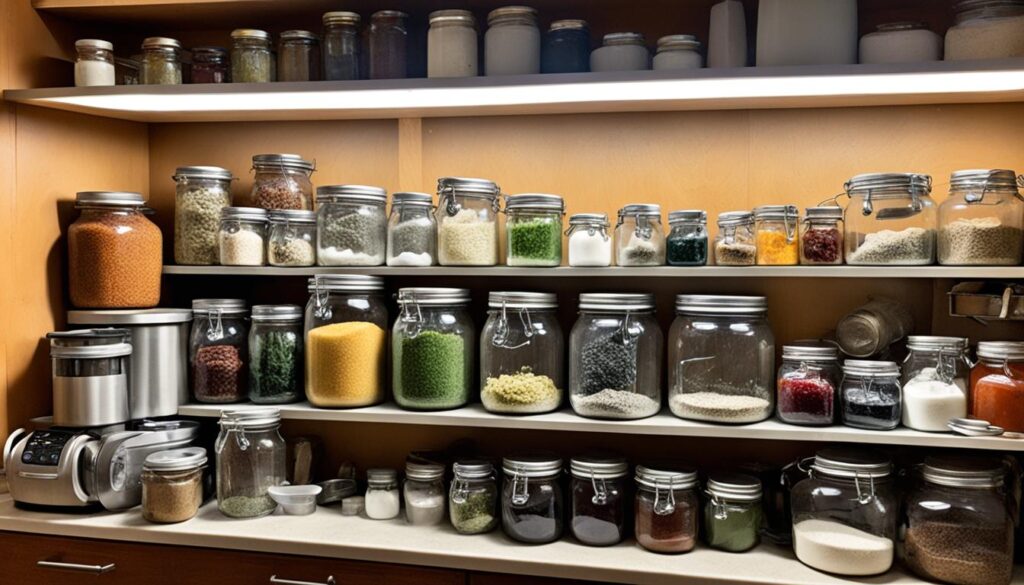
To begin fermenting at home, you only need a few key tools and ingredients. A set of sterilized glass or ceramic jars with tight lids is essential. These jars create the perfect space for your fermented foods to grow.
Essential Equipment
- Fermentation jars: Choose high-quality, food-grade glass or ceramic jars with tight-fitting lids.
- Fermentation weights: These weights keep your vegetables under the brine, stopping mold from growing.
- Fermentation airlock lids: These lids let out carbon dioxide while keeping oxygen out.
Key Ingredients
For fermenting, you need fresh, high-quality produce and salt. Use a natural salt like Kosher or sea salt. Some recipes might need starter cultures, but many can use the bacteria on the vegetables.
- Vegetables: Pick the freshest, locally-sourced produce for the best bacteria.
- Salt: Unrefined salts like Kosher or sea salt are best for fermenting.
- Fermentation starter cultures (optional): These can start the fermentation process.
With these simple tools and ingredients, you’re all set to start fermenting. You can make delicious, gut-healthy fermented foods right at home.
Fermented Foods to Try
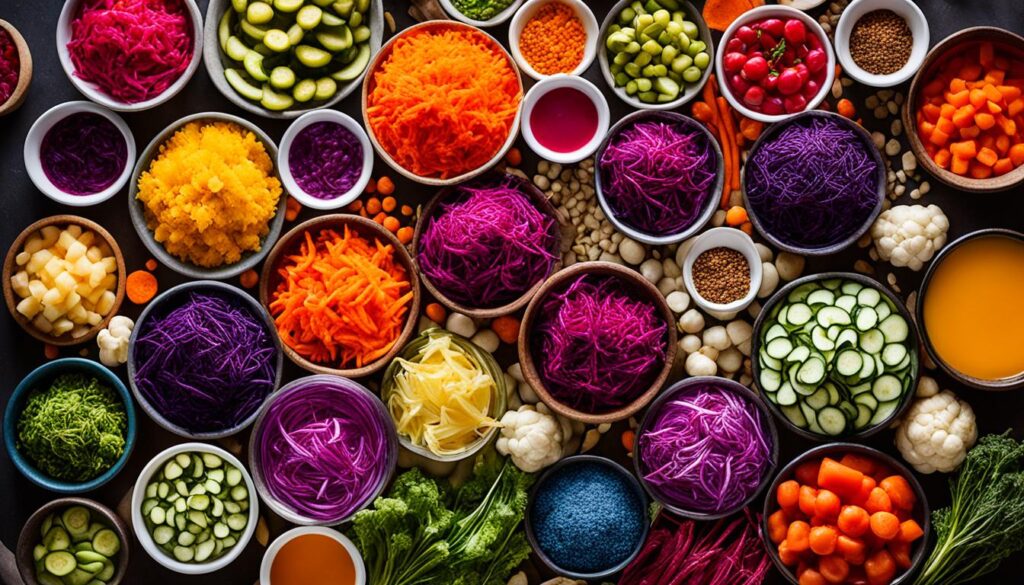
Once you’ve learned the basics of home fermentation, you can try many delicious fermented foods. You can make everything from classic sauerkraut and kimchi to new flavors. These foods are packed with probiotics and can spice up many dishes.
Some popular fermented foods to try at home include:
- Homemade sauerkraut – Shredded cabbage fermented with salt and spices, sauerkraut is great in sandwiches, salads, and more.
- Homemade kimchi – A spicy, flavorful fermented cabbage dish from Korea, kimchi adds a burst of umami to tacos, fried rice, and more.
- Fermented pickles – Cucumbers, peppers, carrots, and other veggies can be turned into probiotic-rich pickles through lacto-fermentation.
- Fermented garlic – Whole garlic cloves fermented in a salt brine become mellow and sweet. They’re great in dressings, dips, and sauces.
- Fermented ginger – Like fermented garlic, ginger develops complex flavors when fermented. It’s perfect for teas, smoothies, and more.
- Fermented carrots – Carrot sticks or coins fermented in a brine become crisp, tangy, and irresistible as a snack or salad topper.
Trying homemade fermented foods is a fun way to explore new flavors and health benefits. With creativity, the possibilities are endless!
Dry Brining vs. Wet Brining
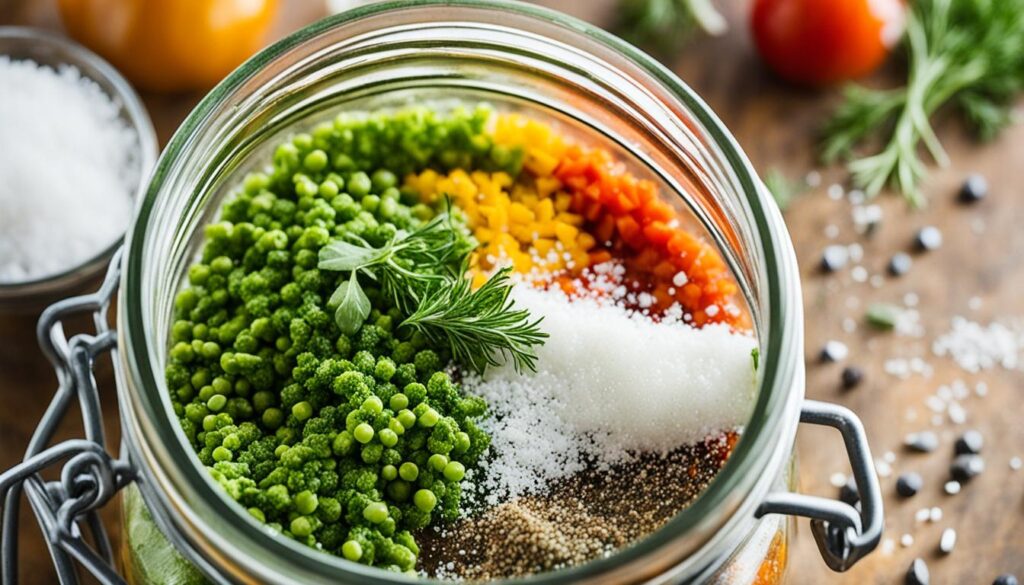
There are two main ways to lacto-ferment vegetables at home: dry brining and wet brining. Both methods create an environment that helps good bacteria grow and stops bad bacteria. But, they are different in some important ways.
Dry Brining Method
Dry brining is often used for making sauerkraut. It involves mixing chopped veggies like cabbage with salt and working them to release juices. This creates a perfect setting for dry brining fermentation. It’s an easy method for beginners, making crunchy, tasty veggies.
The steps are easy:
- Chop or shred the veggies and mix them with salt.
- Work the mix with your hands to get out the juices.
- Put the salty, juicy veggies in a jar, pressing out air.
- Cover it and let it ferment at room temperature for weeks until it tastes right.
This dry brining fermentation method is a gentle way to make tasty, probiotic-rich sauerkraut and other fermented veggies at home.
“Dry brining is a straightforward approach that allows the vegetables’ natural flavors and textures to shine.”
Fermented Foods
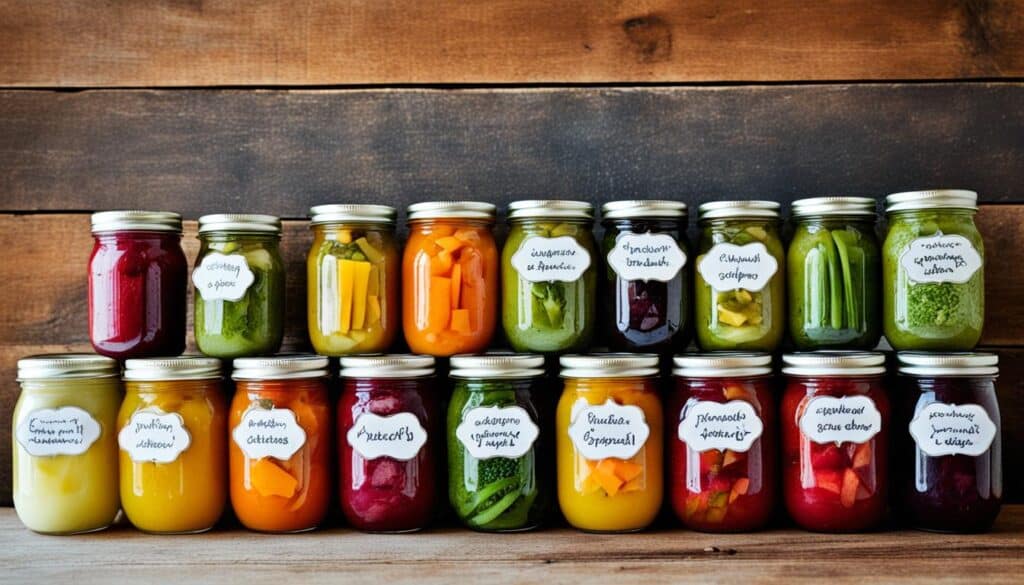
Fermented foods are now a big deal in the food world. They’re loved by those who care about health and food lovers. You can make your own sauerkraut, kimchi, fermented garlic, and ginger at home. By learning how to ferment, you can try different veggies, spices, and flavors to make your own special foods.
More people are trying fermented foods because they taste great and are good for you. These foods are full of probiotics, which help your gut and overall health. Making your own fermented foods lets you enjoy great tastes and a healthy gut.
Exploring the World of Fermented Food Ideas
There are many fermented foods to try, from sauerkraut and kimchi to fermented garlic and ginger. Sauerkraut is a classic German dish that’s tangy and crunchy. Kimchi is a Korean dish made with fermented veggies, each with its own taste.
If you want to try new things, fermented garlic and ginger are great. Fermented garlic is mild and adds a rich flavor to dishes. Fermented ginger is spicy but sweet, making it perfect for many recipes.
| Fermented Food | Flavor Profile | Potential Health Benefits |
|---|---|---|
| Sauerkraut | Tangy, crunchy | Supports gut health, provides probiotics |
| Kimchi | Spicy, tangy, umami | Rich in antioxidants, supports immune function |
| Fermented Garlic | Mellow, umami-rich | Anti-inflammatory properties, supports heart health |
| Fermented Ginger | Spicy, sweet | Aids digestion, provides anti-nausea benefits |
Trying different fermented foods lets you cook more and get health benefits. Whether it’s sauerkraut or fermented garlic, making your own fermented foods is fun and rewarding.
“Fermentation is a time-honored process that transforms simple ingredients into complex, flavorful masterpieces. Unlocking the secrets of homemade ferments can open up a whole new world of culinary exploration and health benefits.”
Also Read : How To Make A Meatloaf With A Flavorful Glaze?
Conclusion
Fermenting foods at home is simple, saves money, and brings unique flavors. It also helps your gut health. By learning about fermentation and some key techniques, anyone can ferment at home. You can start with sauerkraut, kimchi, or try other vegetable ferments.
With the right tools and patience, you can make tasty, probiotic-rich foods at home. This guide covers everything you need to start fermenting. It’s a great way to make flavorful, gut-healthy foods.
Fermented foods are great for your health, helping with digestion and nutrient absorption. Adding them to your diet can boost your well-being. So, why not begin your fermentation journey today? Discover the benefits of these ancient, probiotic-rich foods.
FAQs
Q. What are fermented foods?
Fermented foods are made when natural bacteria and yeast turn sugars and carbs into lactic acid or alcohol. This happens in a special process called fermentation. Lactobacillus bacteria love the salty, acidic conditions and help make these foods.
Q. What are the benefits of fermented foods?
Eating fermented foods can be really good for you. They have probiotics that help your digestion, make nutrients easier to absorb, and boost your immune system. Plus, they break down food before you eat it, so your body gets more out of it.
Q. What equipment is needed for fermenting at home?
You’ll need sterilized jars with tight lids for fermenting. Don’t forget fermentation weights to keep your veggies under the brine. For ingredients, pick fresh produce and use a good salt like Kosher or sea salt.
Q. What are some popular fermented foods to try?
You should try making sauerkraut, kimchi, pickles, and fermented garlic or ginger at home. These foods are full of probiotics and can be added to many dishes. Use them in tacos, on sandwiches, in salads, or in grain bowls.
Q. What are the differences between dry brining and wet brining?
Dry brining is used for sauerkraut and mixes chopped veggies with salt. You massage them to get juices that make the brine. Wet brining dips veggies in a saltwater mix instead. Both methods create a special environment that helps good bacteria grow and keeps bad ones away.
Source Links
- https://www.bbcgoodfood.com/howto/guide/beginners-guide-fermented-foods
- https://zoe.com/learn/fermentation-101
- https://www.souschef.co.uk/blogs/the-bureau-of-taste/the-ultimate-guide-to-fermented-foods?srsltid=AfmBOoq32MjHdzml4y7bAALhO6T_aWxBeznThT3odRvfheSwnLU6KWGv








Leave A Comment